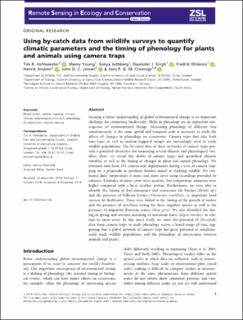Using by-catch data from wildlife surveys to quantify climatic parameters and the timing of phenology for plants and animals using camera traps
Hofmeester, Tim R.; Young, Sherry; Juthberg, Sonya; Singh, Navinder J.; Widemo, Fredrik; Andrén, Henrik; Linnell, John Durrus; Cromsigt, Joris P.G.M.
Journal article
Published version

View/
Date
2019Metadata
Show full item recordCollections
- Scientific publications [1392]
Original version
10.1002/rse2.136Abstract
Gaining a better understanding of global environmental change is an important challenge for conserving biodiversity. Shifts in phenology are an important consequence of environmental change. Measuring phenology of different taxa simultaneously at the same spatial and temporal scale is necessary to study the effects of changes in phenology on ecosystems. Camera traps that take both time-lapse as well as motion-triggered images are increasingly used to study wildlife populations. The by-catch data of these networks of camera traps provide a potential alternative for measuring several climatic and phenological variables. Here, we tested this ability of camera traps, and quantified climatic variables as well as the timing of changes in plant and animal phenology. We obtained data from 193 camera-unit deployments during a year of camera trapping on a peninsula in northern Sweden aimed at studying wildlife. We estimated daily temperature at noon and snow cover using recordings provided by cameras. Estimates of snow cover were accurate, but temperature estimates were higher compared with a local weather station. Furthermore, we were able to identify the timing of leaf emergence and senescence for birches (Betula sp.) and the presence of bilberry berries (Vaccinium myrtillus), as important food sources for herbivores. These were linked to the timing of the growth of antlers and the presence of new-born young for three ungulate species as well as the presence of migratory Eurasian cranes (Grus grus). We also identified the timing of spring and autumn moulting of mountain hares (Lepus timidus) in relation to snow cover. In this novel study, we show the potential of (by-catch) data from camera traps to study phenology across a broad range of taxa, suggesting that a global network of camera traps has great potential to simultaneously track wildlife populations and the phenology of interactions between animals and plants.
